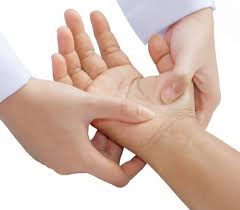We take for granted just how much work our hands and wrists do every day. Typing, texting, opening doors and driving a car - these extremities are very busy all day long. But for people suffering from carpal tunnel syndrome, simple daily tasks such as buttoning a shirt or lifting a plate of food become painful.
More than 8 million Americans are affected with carpal tunnel syndrome each year, and with symptoms showing up more often in women between the ages of 40-70. Carpal tunnel syndrome occurs when there is pressure on the median nerve in your wrist. This nerve runs from the forearm to the hand through a small area called the carpal tunnel. When experiencing pressure, a person will often have weakness, tingling and even numbness in the wrist and fingers.
What Causes Carpal Tunnel Syndrome?
Many factors put you at risk for carpal tunnel syndrome:.
· Repetitive motion is a big cause of carpal tunnel syndrome, and is most often seen in the workplace. People who do jobs that require all-day driving, a lot of typing, working with small tools or instruments, packing and loading objects or writing will find they’re at risk for carpal tunnel syndrome.
· Inflammatory diseases such as rheumatoid arthritis, hypothyroidism or diabetes can cause swelling that can put pressure on the nerves and lead to carpal tunnel syndrome.
· Pregnancy is another risk factor leading to carpal tunnel syndrome.
Relieving the Pain
Once diagnosed with carpal tunnel syndrome, patients might find relief from simple things such as reducing the amount of repetitive work being done, taking frequent rest breaks, putting ice packs on the area for 10-15 minutes a couple of times a day or wearing a splint to relieve the pressure.
If those measures fail, it is time to seek medical treatment. Many people opt for surgery, but studies show that in 75 percent of cases of carpal tunnel syndrome treated with surgery, symptoms return within two years. Research has found that many times this pain and weakness is caused by problems with the alignment of the neck, which isn’t fixed with surgery.
Chiropractic care offers a non-invasive approach to treating carpal tunnel syndrome. At Foster Chiropractic Sports & Wellness, we are proud to be able to offer services that treat extremities, as Dr. Scott Foster is one of the only area chiropractors certified to adjust extremities. A chiropractic approach to treating carpal tunnel syndrome will first focus on the wrist and arm to relieve the pain, and then will work on any issues in the neck that might be causing undue pressure. We will also recommend home exercises to help with the pain.
As with many types of pain, maintaining a healthy lifestyle is also important. Maintaining a healthy weight and avoiding smoking and drinking alcohol can also help avoid symptoms of carpal tunnel syndrome.
If you are suffering from pain or weakness in your wrists and hands, call us today. We can help you get back to all of your normal activities and live pain free.

